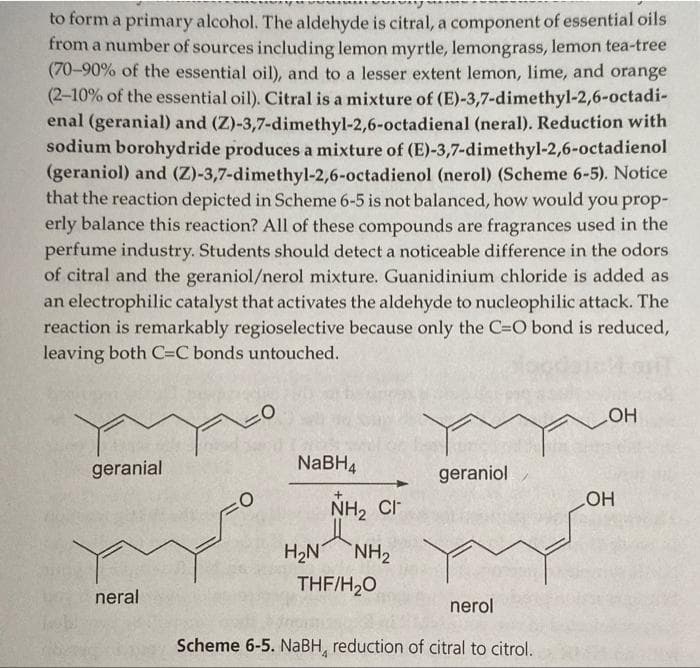Chemistry
10th Edition
ISBN:9781305957404
Author:Steven S. Zumdahl, Susan A. Zumdahl, Donald J. DeCoste
Publisher:Steven S. Zumdahl, Susan A. Zumdahl, Donald J. DeCoste
Chapter1: Chemical Foundations
Section: Chapter Questions
Problem 1RQ: Define and explain the differences between the following terms. a. law and theory b. theory and...
Related questions
Question
5
how would you properly balance this reaction?

Transcribed Image Text:to form a primary alcohol. The aldehyde is citral, a component of essential oils
from a number of sources including lemon myrtle, lemongrass, lemon tea-tree
(70-90% of the essential oil), and to a lesser extent lemon, lime, and orange
(2-10% of the essential oil). Citral is a mixture of (E)-3,7-dimethyl-2,6-octadi-
enal (geranial) and (Z)-3,7-dimethyl-2,6-octadienal (neral). Reduction with
sodium borohydride produces a mixture of (E)-3,7-dimethyl-2,6-octadienol
(geraniol) and (Z)-3,7-dimethyl-2,6-octadienol (nerol) (Scheme 6-5). Notice
that the reaction depicted in Scheme 6-5 is not balanced, how would you prop-
erly balance this reaction? All of these compounds are fragrances used in the
perfume industry. Students should detect a noticeable difference in the odors
of citral and the geraniol/nerol mixture. Guanidinium chloride is added as
an electrophilic catalyst that activates the aldehyde to nucleophilic attack. The
reaction is remarkably regioselective because only the C=O bond is reduced,
leaving both C=C bonds untouched.
geranial
NABH4
geraniol
HO
NH, CI
H2N
NH2
THF/H20
neral
nerol
Scheme 6-5. NABH, reduction of citral to citrol.
Expert Solution
This question has been solved!
Explore an expertly crafted, step-by-step solution for a thorough understanding of key concepts.
This is a popular solution!
Trending now
This is a popular solution!
Step by step
Solved in 3 steps with 4 images

Knowledge Booster
Learn more about
Need a deep-dive on the concept behind this application? Look no further. Learn more about this topic, chemistry and related others by exploring similar questions and additional content below.Recommended textbooks for you

Chemistry
Chemistry
ISBN:
9781305957404
Author:
Steven S. Zumdahl, Susan A. Zumdahl, Donald J. DeCoste
Publisher:
Cengage Learning

Chemistry
Chemistry
ISBN:
9781259911156
Author:
Raymond Chang Dr., Jason Overby Professor
Publisher:
McGraw-Hill Education

Principles of Instrumental Analysis
Chemistry
ISBN:
9781305577213
Author:
Douglas A. Skoog, F. James Holler, Stanley R. Crouch
Publisher:
Cengage Learning

Chemistry
Chemistry
ISBN:
9781305957404
Author:
Steven S. Zumdahl, Susan A. Zumdahl, Donald J. DeCoste
Publisher:
Cengage Learning

Chemistry
Chemistry
ISBN:
9781259911156
Author:
Raymond Chang Dr., Jason Overby Professor
Publisher:
McGraw-Hill Education

Principles of Instrumental Analysis
Chemistry
ISBN:
9781305577213
Author:
Douglas A. Skoog, F. James Holler, Stanley R. Crouch
Publisher:
Cengage Learning

Organic Chemistry
Chemistry
ISBN:
9780078021558
Author:
Janice Gorzynski Smith Dr.
Publisher:
McGraw-Hill Education

Chemistry: Principles and Reactions
Chemistry
ISBN:
9781305079373
Author:
William L. Masterton, Cecile N. Hurley
Publisher:
Cengage Learning

Elementary Principles of Chemical Processes, Bind…
Chemistry
ISBN:
9781118431221
Author:
Richard M. Felder, Ronald W. Rousseau, Lisa G. Bullard
Publisher:
WILEY